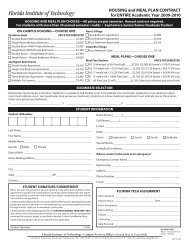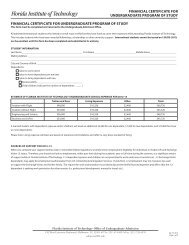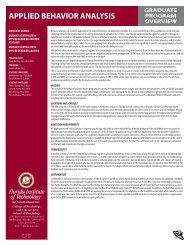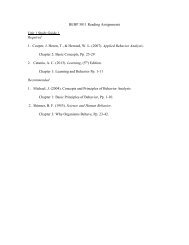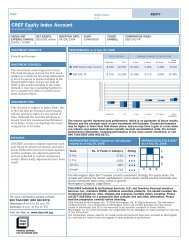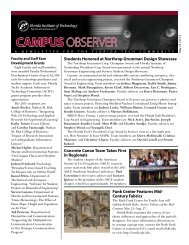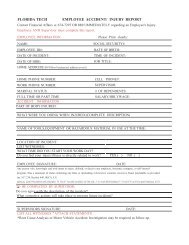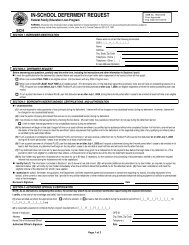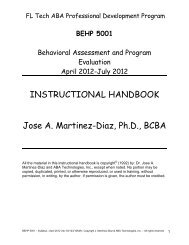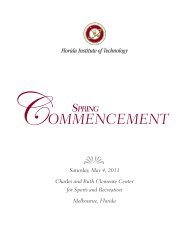2006–2007 - Florida Institute of Technology
2006–2007 - Florida Institute of Technology
2006–2007 - Florida Institute of Technology
Create successful ePaper yourself
Turn your PDF publications into a flip-book with our unique Google optimized e-Paper software.
ECE 2111 CIRCUIT THEORY 1 (4 credits). Includes concepts <strong>of</strong> transient<br />
and steady-state behavior <strong>of</strong> passive electrical circuits; techniques for circuit analysis<br />
including mesh and nodal analysis and equivalent circuits; first- and secondorder<br />
circuits, superposition, Laplace transform techniques; and lab projects.<br />
Prerequisites: PHY 1001. Corequisites: MTH 2201.<br />
ECE 2112 CIRCUIT THEORY 2 (4 credits). Continues ECE 2111. Includes<br />
phasors and steady-state response; AC power and two-port equivalent circuits and<br />
transfer functions; Fourier analysis transforms analysis, Laplace transforms; and<br />
lab projects. Prerequisites: ECE 2111.<br />
ECE 2551 SOFTWARE/HARDWARE DESIGN (3 credits). Studies<br />
s<strong>of</strong>tware and hardware aspects <strong>of</strong> computer design and corresponding interdependencies.<br />
Includes use <strong>of</strong> C++ and current graphical s<strong>of</strong>tware development<br />
environments. Lab includes the application <strong>of</strong> high-level language concepts to<br />
manipulate microcomputers, graphical-user interfaces and communication ports.<br />
(CL) Prerequisites: ECE 1552.<br />
ECE 2552 SOFTWARE/HARDWARE INTEGRATION (3 credits).<br />
Progresses from developing s<strong>of</strong>tware/hardware modules to the vertical system <strong>of</strong><br />
hardware device drivers, operating systems and application user interfaces. Applies<br />
current s<strong>of</strong>tware engineering techniques including data structures to integrate<br />
s<strong>of</strong>tware and hardware using modern programming languages (e.g., C++). (CL)<br />
Prerequisites: ECE 2551.<br />
ECE 3111 ELECTRONICS (4 credits). Introduces diodes, bipolar and<br />
field-effect transistors; analysis and design <strong>of</strong> semiconductor circuits; single and<br />
multistage amplifiers; design algorithms; operational amplifiers and oscillators.<br />
Includes lab projects. Prerequisites: ECE 2111.<br />
ECE 3222 SIGNALS AND SYSTEMS (3 credits). Covers properties<br />
and applications <strong>of</strong> Fourier, Laplace and z-transforms to linear continuous and<br />
discrete systems, and introduces state-space description <strong>of</strong> systems. Prerequisites:<br />
ECE 2112.<br />
ECE 3240 JUNIOR DESIGN (1 credit). Introduces the concepts, principles<br />
and methodology <strong>of</strong> collaborative electrical or computer engineering design<br />
through seminars, discussions and interaction with seniors completing their<br />
capstone design projects. Students form teams and study the feasibility <strong>of</strong> potential<br />
senior project selections. (Requirement: Junior standing.)<br />
ECE 3331 ELECTRON DEVICES (3 credits). Studies semiconductor materials<br />
and physics, electrons and holes, semiconductor diodes, bipolar transistors and<br />
field effect devices. Prerequisites: MTH 2201, PHY 2003.<br />
ECE 3441 ELECTROMAGNETIC FIELDS (3 credits). Covers vector calculus,<br />
solutions <strong>of</strong> electrostatic and magnetostatic fields, electromagnetic boundary<br />
conditions, time-changing electric and magnetic fields, and Maxwell’s equations.<br />
Prerequisites: MTH 2001, PHY 2002.<br />
ECE 3442 ELECTROMAGNETIC WAVES (3 credits). Addresses validity<br />
<strong>of</strong> circuit principles at high frequencies, electromagnetic wave on lines, impedance<br />
measurements using Smith chart, impedance matching techniques, waveguides<br />
and fiber-optical transmission systems, antennas and radiation waves, satellite data<br />
links and radar systems. Prerequisites: ECE 2112.<br />
ECE 3541 DIGITAL STATE MACHINES (3 credits). Includes set theory,<br />
order and equivalence relations, partitions, lattices, generating functions, cardinality,<br />
elementary number theory, graph theory, planar graphs, directed graphs, finite<br />
state machines, finite automata. Prerequisites: ECE 1552, MTH 1002.<br />
ECE 3551 MICROCOMPUTER SYSTEMS 1 (4 credits). Introduces<br />
applications <strong>of</strong> microprocessors, microprocessor architecture, assembly programming,<br />
hardware configuration, memory section design, input/output and exception<br />
processing. Includes lab projects. Prerequisites: ECE 1552, ECE 2111.<br />
ECE 3552 MICROCOMPUTER SYSTEMS 2 (4 credits). Covers design<br />
<strong>of</strong> microcomputer systems interfacing and their peripherals; interrupts, exception<br />
processing and hardware/s<strong>of</strong>tware integration; small-system controller design using<br />
microcontrollers. Includes lab projects. Prerequisites: ECE 3111, ECE 3551.<br />
ECE 3553 MULTIFARIOUS SYSTEMS 1 (4 credits). Studies vertical<br />
integration <strong>of</strong> many dissimilar systems at the hardware and s<strong>of</strong>tware level. Includes<br />
digital logic, microcontroller structure and design; machine code and advanced<br />
C++. Covers design and integration <strong>of</strong> dissimilar systems that use differing hardware,<br />
s<strong>of</strong>tware languages and operating environments. Also includes case studies<br />
and several common programming languages. Prerequisites: ECE 2552.<br />
ECE 4001 SPECIAL TOPICS IN ELECTRICAL AND COMPUTER<br />
ENGINEERING (1 credit). Offers lab or lecture in selected fields <strong>of</strong> computer<br />
and electrical engineering. May be repeated as needed.<br />
ECE 4112 DIGITAL ELECTRONICS (3 credits). Includes relevant physics,<br />
electronics and transmission line theory important to modern computers.<br />
Important device-level concepts used to build digital systems are introduced and<br />
used to design integrated circuits with primary focus on interface requirements.<br />
Transmission line theory relevant to system-level interconnect and network<br />
requirements. Prerequisites: ECE 3111, PHY 2003.<br />
ECE 4221 COMMUNICATION SYSTEMS (3 credits). Includes review <strong>of</strong><br />
signals in electrical communication; Fourier transform, noise and signal-to-noise<br />
ratio, power spectral density and autocorrelation function, linear (amplitude)<br />
modulation; exponential (angle) modulation; generation and detection <strong>of</strong> amplitude<br />
and angle modulated waves; sampling theory. Prerequisites: ECE 3222.<br />
ECE 4224 COMMUNICATIONS AND CONTROL SYSTEMS LABORA-<br />
TORY (3 credits). Includes experiments on VCOs, tuned circuits, amplifiers,<br />
filters, balanced modulator, AM and FM generation and detection, sampling<br />
aliasing. Control theory experiments (OP-AMP stability, cardiac pacemaker<br />
control, single axis lunar excursion module, magnetic levitation system) using<br />
MATLAB. Corequisites: ECE 4221.<br />
ECE 4226 PATTERN RECOGNITION AND DETECTION (3 credits).<br />
Introduces Bayesian adaptive and nonadaptive decision and its application to the<br />
design, analysis and evaluation <strong>of</strong> optimal systems for detection, pattern recognition<br />
and feature extraction. Includes applications to communications, failure<br />
detection and target detection and recognition.<br />
ECE 4231 CONTROL SYSTEMS (3 credits). Covers analysis and design<br />
<strong>of</strong> linear time-invariant control systems. Includes electrical, mechanical, thermal,<br />
fluid and information handling elements encountered in control systems; modeling<br />
<strong>of</strong> systems <strong>of</strong> interconnected elements; transfer function (classical) and state<br />
space (modern) descriptions <strong>of</strong> control systems; signal flow graphs. Prerequisites:<br />
ECE 3222.<br />
ECE 4241 SYSTEM DESIGN 1 (3 credits). Applies engineering design fundamentals<br />
to student design projects. Includes the study <strong>of</strong> the design process and<br />
related topics such as optimization techniques, reliability prediction, engineering<br />
economics, safety, aesthetics, ethics and social impact. Students carry out a project<br />
from conception through design, fabrication, testing and delivery. (Requirement:<br />
Senior standing.)<br />
ECE 4242 SYSTEM DESIGN 2 (3 credits). Applies engineering design fundamentals<br />
to student design projects. Includes the study <strong>of</strong> the design process and<br />
related topics such as optimization techniques, reliability prediction, engineering<br />
economics, safety, aesthetics, ethics and social impact. Students carry out a project<br />
from conception through design, fabrication, testing and delivery. (Requirement:<br />
Senior standing.) Prerequisites: ECE 4241.<br />
ECE 4311 MICROELECTRONICS FABRICATION LABORATORY<br />
(3 credits). Students fabricate silicon p-channel transistors. Includes lectures<br />
on transistor processing and fabrication in the clean room. (Requirement: Senior<br />
standing or instructor approval.)<br />
ECE 4330 INTEGRATED CIRCUIT DESIGN AND LAYOUT<br />
LABORATORY (3 credits). Introduces the design and layout <strong>of</strong> integrated<br />
circuits at the transistor level. Integrated circuits are designed using standard<br />
engineering techniques. Stresses the understanding and use <strong>of</strong> IC development<br />
tools. Prerequisites: ECE 3111.<br />
ECE 4332 ELECTROOPTIC DEVICES AND SYSTEMS (3 credits).<br />
Discusses the theory <strong>of</strong> operation <strong>of</strong> key photonic/fiber-optic devices used in a<br />
wide variety <strong>of</strong> electronic systems. Devices include lasers, light emitting diodes,<br />
photodetectors, CCD arrays, liquid crystal displays, optical fibers, etc. Explains<br />
the basic operation <strong>of</strong> various electrooptic systems. Prerequisites: ECE 3331,<br />
ECE 3442.<br />
ECE 4333 LIGHTWAVE LABORATORY (3 credits). Lectures and introductory<br />
experiments in fiber-optics. Emphasizes typical components, and communication<br />
and sensor systems. (Requirement: Senior standing in ECE or instructor<br />
approval.) Prerequisites: PHY 2003.<br />
ECE 4342 VIRTUAL INSTRUMENTATION LAB (3 credits). Lectures and<br />
experiments in programming, data acquisition and analysis <strong>of</strong> virtual instruments<br />
using state-<strong>of</strong>-the-art and industry standard virtual instrumentation s<strong>of</strong>tware and<br />
hardware tools. (Requirement: Senior standing in ECE or instructor approval.)<br />
ECE 4551 COMPUTER ARCHITECTURE (3 credits). Covers instruction<br />
set design, processor and control unit design, handling <strong>of</strong> exceptions, ALU arithmetic<br />
and implementation, pipelining, pipeline hazards, memory hierarchy, cache<br />
memory types and I/O interface design. Prerequisites: CSE 3101 or ECE 3551.<br />
ECE 4561 COMPUTER COMMUNICATIONS (3 credits). Theory, design<br />
and analysis <strong>of</strong> computer communication systems. Includes TCP/IP, Internet, the<br />
World Wide Web, ISO-OSI network architecture, LANs, wireless communications,<br />
satellite networks, UNIX network programming, network modeling and<br />
simulation. Prerequisites: ECE 2552.<br />
ECE 4681 INTRODUCTION TO ELECTRICAL POWER SYSTEMS<br />
(3 credits). Comprehensively studies power system modeling and analysis.<br />
Includes power system representation, transmission lines, transformers, machines,<br />
the power-flow problem, operation and control, fault analysis and protection.<br />
Prerequisites: ECE 2112 or ECE 4991.<br />
ECE 4800 INDEPENDENT STUDY (3 credits). Special projects are undertaken<br />
on a cooperative basis between a student and a member <strong>of</strong> the faculty. May<br />
include such work as a literature search in a given area <strong>of</strong> design and fabrication <strong>of</strong><br />
equipment as a laboratory project.<br />
Course Descriptions 181



